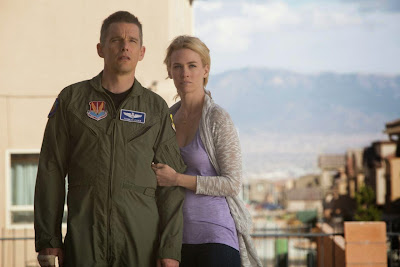★★
- I saw this on a regular-sized theater screen in 2-D.
There have been two big booms of disaster films in cinema history. One lasted the whole of the 1970s and the other lasted through the last half of the 1990s. Where the 1970s ones such as The Poseidon Adventure, the Airport films, Earthquake, The Swarm, etc. focused on big Hollywood stars both of the classic golden era and new trying to survive, the 1990s ones were about singular family units trying to survive or scientists trying to survive after their warnings go unheeded. It's commonly suggested that the 1970s disaster films were better, as they had good, proven actors, and a lot of them. This allowed the films to have the excitement of watching things get destroyed, not letting the audience know who was going to die and when because all the actors were big names, and allowed us to have some believable character development too. The 1990s films were all due to the fact that with advancements in special effects, we could more convincingly and cheaply destroy things. Sadly, San Andreas is more in the vein of a 1990s disaster film than a 1970s one.
San Andreas stars Dwayne 'The Rock' Johnson as Ray, a Los Angeles city search and rescue helicopter pilot. He's good at what he does. However, his family had a tragedy some time ago, and he's chosen not to deal with it. This makes his wife leave him and she's now moving in with a really rich dude and serving him divorce papers. The rich guy, Daniel Riddick, a building designer, seems like a good enough guy. Seriously, the characters are so thin, this is about all I can say about him. Meanwhile, Ray is supposed to take his daughter to college, but alas, an earthquake strikes the Hoover Dam area, ruining the dam and sending lots and lots of water rushing into the area. Present at the dam was a Cal Tech scientist named Lawrence, played by Paul Giamatti, who is working on earthquake predictions. The data he gets there shows him that this quake was not going to be the last. There will be more, they will be bigger, and there's nothing they can do to stop it. And in no time at all, an earthquake hits Los Angeles. Right as Ray is told to take his chopper and help Nevadans, he turns tail and goes to rescue his wife with city equipment. (The whole movie I just kept thinking, "Guy is gonna get so sued by the city. Probably gonna get many years in jail. This is unethical.") Oh, there's also a British guy (Hugo Johnstone-Burk) and his little brother, Ollie (Art Parkinson, the kid that played Rickon Stark in Game of Thrones.) who meet up with Ray's daughter Blake (Alexandra Deddario) and become her entourage once the initial LA quake hits. I guess they're there for comic relief and child-in-danger suspense? From there on what story we have becomes pretty unimportant as the movie shifts to as much destruction and mayhem as possible. I personally did not mind that as I was expecting nothing else, but destruction does not a well crafted movie make. However, this means that some characters that are set up early on just disappear without a word and don't really come back into the story.
The movie is directed by Brad Peyton, who before this did only two movies, both aimed at the grade school crowd. Cats & Dogs 2: Revenge of Kitty Galore and Journey 2: The Mysterious Island, the latter of which he also worked with Dwayne Johnson on. This is not a great resume, but it's not horrible either. It just shows that he's competent with special effects films, and he doesn't pick the best scripts. The script was a bit surprising though, coming from Carlton Cuse, writer of such televison as Adventures of Brisco County Jr., Bates Motel, Lost, and Nash Bridges. He knows how to write, but this is not his best work.
 |
| Yes, there is a tsunami too. |
So if you want little more than wanton destruction and people falling from buildings or buildings falling on them, this movie is a good bet for you. It's what I wanted, and I got it. But if you want believability, good characters, or even good acting, look elsewhere. The family storyline is cliched and the dialogue/delivery is cheesy as it gets. I'd say it's about on the level of Twister when it comes to disaster films. However, it's not as memorable, and it doesn't have Bill Paxton or Cary Elwes, which is a shame. No, instead we get a Kylie Minogue cameo. Yay us?


















